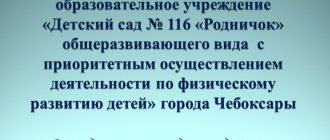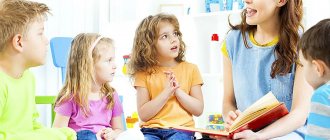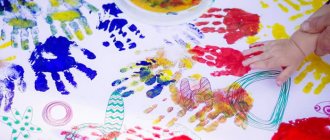Presentation “History of a preschool educational institution”
Irina Gerasimova
Presentation “History of a preschool educational institution”
MBDOU "Kindergarten No. 116 "Rodnichok"
Cheboksary-
The foundation laying took place in the fall of 1978. On the slope of the ravine lay a brick, blocks for the foundation and unassembled crane - this is what appeared to the gaze of Nadezhda Alekseevna Krylova, the future head of kindergarten No. 116 “Rodnichok”
.
Exactly a year later, in the fall of 1979, Nadezhda Alekseevna was appointed head of this kindergarten, which she successfully led for 30 years. The kindergarten building at that time had huge windows, there was no greenhouse or swimming pool. The director of the Cheboksary Aggregate Plant, Georgy Maryanovich Pilyarsky, after a creative trip to one of the regions of the Soviet Union, saw a kindergarten with a swimming pool and was eager to build the same in our city. This is how the first kindergarten with a swimming pool appeared in the city of Cheboksary. 330 children were supposed to come to the kindergarten, whose parents worked 250 hours on the improvement of the kindergarten.
The design solutions for the shade canopies were not well thought out, since not every group had an individual shade canopy, so a new project was approved, agreed with the chief architect of the city, Kilyakov.
In the fall of 1979 They brought tiny seedlings for the plots in the amount of 5000 pieces, which were planted by the parents of future pupils on the territory of the sites of groups: 6,12,7,2,1,3,10 and 8, but these seedlings were not enough and five employees, led by the head, went to dig up the missing seedlings in the airport area. Spring and summer 1980 Work was in full swing to open a kindergarten. At that time, not a single furniture factory in our republic produced children’s furniture, so the head of the kindergarten Krylova N.A. went on a business trip to Novorossiysk, where furniture for the kindergarten was ordered and delivered in 5 carriages to our city.
November 1, 1980 kindergarten No. 116 “Rodnichok”
opened its doors. There is such a belief:
“Which child comes first to kindergarten, such a kindergarten will be
.
The first on the list was the calm, cheerful and cheerful girl Tanya Borodina, who was received by the preparatory group teacher Valentina Elizarovna Kuznetsova. The girl liked the group and the toys, she was happy to make contact with the teacher, and the whole team breathed a sigh of relief. For 10 years, the kindergarten successfully sent children to school, having a physical education and music hall in one person.
In 1991, at the beginning of perestroika, the kindergarten was closed for major renovations. In the most difficult and difficult time, when there were big problems with financing and materials, despite all the difficulties the kindergarten survived, the renovation was successful and in the fall of 1994. accepted children again. As a result of the reconstruction, new functional rooms appeared: music and physical education rooms, a design room, fine arts, a psychology room, the pedagogical office was expanded, a greenhouse was built, and a medical office conducts health-improving work with children.
The kindergarten of the future is an institution with highly qualified specialists, with the active work of all functional premises, with extensive computerization and the use of nanotechnology.
Educational work is carried out in close contact with parents and higher organizations, and with decent funding. To ensure a comfortable and favorable stay for children in kindergarten, create individually differentiated groups in four parallels, in which an individual approach to each child would be provided. More functional rooms in group rooms: playroom, study room, dining room, mandatory work on teaching children to swim in the pool , the creation of a skating rink, a bicycle track, as well as a sports ground equipped with the latest technology.
One of the most pressing problems today is the shortage of kindergartens in the territory, not only of the Chuvash Republic, but also of the Russian Federation. Thanks to the attention of the president , this problem is gradually being resolved in our country: the construction of new kindergartens is planned, buildings transferred to other structures are being returned.
The main event that our kindergarten carried out in order to increase the number of places for children was to make fuller use of the design capacity of the building, in which functional classrooms were previously deployed due to lack of staffing with children. For more complete use, some functional classrooms were closed, thereby not infringing on the subject-development environment, but provided 20 places, reducing the queue for kindergartens.
We also use traditional forms and methods of work: provision of various advisory services by kindergarten specialists, publication of newspapers for parents, visual information materials, organization of various leisure activities. We invite unorganized children to participate in relay races, sports events, concerts, drawing exhibitions, and various competitions.
Presentation “Federal State Educational Standard for Preschool Education” presentation for a lesson on the topic
Slide 1
Federal state educational standards for preschool education.
Slide 2
The concept of the Federal State Educational Standard (English standard - norm, sample) - “sample, standard, model, taken as the initial ones for comparing other similar objects with them” “Standard - a set of norms, rules, requirements that are established on the basis of the achievements of science, technology and excellence; minimum requirements (for products) established to protect the health and safety of consumers; guarantees are conditions and mechanisms that ensure the unhindered enjoyment of rights and their comprehensive protection.” A standard in education should act as a guarantee of the constitutional right of a Russian citizen, the right of any person to a quality education. The Federal State Educational Standard is a system of basic parameters that are accepted as the state standard of education, reflecting the social ideal and taking into account the capabilities of the real individual and the education system to achieve this ideal. The Federal State Educational Standard for Preschool Education reflects agreed upon socio-cultural, public and state expectations regarding the level of preschool education, which are guidelines for the founders of preschool Organizations, education system specialists, families of pupils and the general public.
Slide 3
The standard was developed on the basis of: the UN Convention on the Rights of the Child Constitution of the Russian Federation Legislation of the Russian Federation The standard reflects the following expectations: social - social - state cultural
Slide 4
The standard states the basic principles: ● preserving the uniqueness and intrinsic value of preschool childhood as an important stage in the overall development of a person; ● full-fledged living by the child of all stages of preschool childhood, amplification (enrichment) of child development; ● creating a favorable social situation for the development of each child in accordance with his age and individual characteristics and inclinations; ● assistance and cooperation between children and adults in the process of children's development and their interaction with people, culture and the outside world; ● introducing children to socio-cultural norms, traditions of the family, society and state; ● formation of the child’s cognitive interests and cognitive actions through his inclusion in various types of activities; ● taking into account the ethnocultural and social situation of children's development.
Slide 5
The goals of the Federal State Educational Standard are to ensure that the state has equal opportunities for every child to receive quality preschool education; ensuring state guarantees of the level and quality of education based on the unity of mandatory requirements for the conditions for the implementation of basic educational programs, their structure and the results of their development; maintaining the unity of the educational space of the Russian Federation regarding the level of preschool education.
Slide 6
protection and strengthening of the physical and mental health of children; preserving and supporting the child’s individuality, developing the individual abilities and creative potential of each child as a subject of relationships with people, the world and himself; the formation of a general culture of students, the development of their moral, intellectual, physical, aesthetic Objectives of the Federal State Educational Standard for Education qualities, initiative, independence and responsibility, the formation of prerequisites for educational activities; ensuring variability and diversity of the content of educational programs and organizational forms of the level of preschool education, taking into account the educational needs and abilities of students; the formation of a sociocultural environment that corresponds to the age and individual characteristics of children; ensuring equal opportunities for the full development of each child during preschool childhood, regardless of place of residence, gender, nation, language, social status, psychophysiological characteristics (including disabilities); ensuring continuity of basic educational programs of preschool and primary general education; determining directions for systematic interdepartmental interaction, as well as interaction between pedagogical and public associations (including network ones).
Slide 7
Federal State Educational Standard for Education recommends planning educational work, covering the following educational areas: Social and communicative development Cognitive development Physical development Speech development Artistic and aesthetic development
Slide 8
Implementation stages Creation of a working group Development of a schedule for 2013 – 2014 Adjustment of the planning grid taking into account the Federal State Educational Standard for Preschool Education Development of the main educational program of a preschool educational institution in accordance with the Federal State Educational Standard for Preschool Education.
Slide 9
Regime moments Educational area OO Forms of organizing joint activities of teachers with children Organization of a developmental environment for independent activities of children Morning, reception of children, preparation for breakfast, breakfast GCD 1. Topic Tasks GCD 2. Topic Tasks Walk II half of the day: Interaction with parents, teachers of preschool educational institutions Date, day of week _________________________________ Subject _____________________________________
Slide 10
Requirements for the conditions for the implementation of PEP RESULT - the creation of a social development situation for participants in educational relations, including the creation of an educational environment that: ● guarantees the protection and strengthening of the physical and mental health of students; ● ensures the emotional and moral well-being of pupils; ● promotes the professional development of teaching staff; ● creates conditions for developing variable preschool education; ● ensures its openness and motivating character. psychological and pedagogical conditions personnel conditions material and technical conditions financial conditions developing subject-spatial environment
Slide 11
Requirements for psychological and pedagogical conditions ● teachers’ respect for the human dignity of students, the formation and support of their positive self-esteem, confidence in their own capabilities and abilities; ● the use in the educational process of forms and methods of working with children that correspond to their psychological, age and individual characteristics (inadmissibility of both artificial acceleration and artificial slowdown of children’s development); ● building an educational process based on interaction between adults and children, focused on the interests and capabilities of each child and taking into account the social situation of his development; ● support by teachers of a positive, friendly attitude of children towards each other and the interaction of children in different types of activities; ● supporting children’s initiative and independence in activities specific to them; ● the opportunity for children to choose materials, types of activities, participants in joint activities and communication; ● protection of children from all forms of physical and mental violence; ● building interaction with the families of pupils in order to achieve the full development of each child, involving the families of pupils directly in the educational process.
Slide 12
The organization must create opportunities: ● to provide information about the Program to the family and all interested parties involved in the educational process, as well as the general public; ● for teachers to search and use materials that ensure the implementation of the Program, including in the information environment; ● to discuss with parents (legal representatives) of pupils issues related to the implementation of the Program. The Organization must create conditions for: ● advanced training of teaching and management employees (including by their choice) and their professional development; ● advisory support for teachers and parents on issues of inclusive education if it is organized; ● organizational and methodological support for the implementation of the Program, including in terms of interaction with society.
Slide 13
Requirements for personnel conditions The organization must be staffed with qualified personnel (“Higher vocational education or secondary vocational education in the field of training “Education and Pedagogy” without presenting requirements for work experience and additional professional education in the field of training “Education and Pedagogy” without presenting requirements for work experience work", EKS dated August 26, 2010). The implementation of the Program is carried out by: 1) educators during the entire period of stay of students in the Organization. Each group must be continuously accompanied by a teacher or other teacher; 2) other teaching staff, the corresponding positions for which are established by the Organization independently, depending on the content of the Program; 3) teaching assistants and other employees take part in creating the conditions necessary for the implementation of the educational program. The implementation of the Program requires the Organization to manage educational activities, methodological support for the implementation of the Program, accounting, financial and economic activities, and the necessary medical support. To solve these problems, appropriate qualified personnel are attracted as employees of the Organization and/or contracts are concluded with organizations providing relevant services.
Slide 14
Requirements for material and technical conditions 1) requirements determined in accordance with sanitary and epidemiological rules and regulations, including: ● for buildings (premises) and areas of the Organization (group); ● to water supply, sewerage, heating and ventilation of buildings (premises) of the Organization (group); ● to the set and area of educational premises, their decoration and equipment; ● to artificial and natural lighting of educational premises; ● to the sanitary condition and maintenance of premises; ● to equip premises for high-quality meals for pupils; 2) requirements determined in accordance with fire safety rules; 3) equipment of premises for the work of medical personnel in the Organization.
Slide 15
Requirements for financial conditions Financial conditions for the implementation of the Program must: ● provide the Organization with the ability to comply with the requirements of the Standard for the conditions of implementation and structure of the Program; ● ensure the implementation of the mandatory part of the Program and the part formed by participants in the educational process, taking into account the variability of individual development trajectories of students; ● reflect the structure and volume of expenses necessary for the implementation of the Program, as well as the mechanism for their formation. The volume of financial support for the implementation of the Program is determined based on the Requirements for the conditions for the implementation of the educational program BEFORE this Standard and must be sufficient and necessary for the Organization to incur expenses: for remuneration of employees implementing the Program; for teaching aids, relevant materials, including consumables, gaming, sports, health equipment, inventory, payment for communication services, including costs associated with connecting to the Internet information network; related to additional professional education of teaching staff in the profile of their activities; others related to the implementation of the Program.
Slide 16
Requirements for a developing subject-spatial environment A developing subject-spatial environment (DSES) ensures maximum realization of the educational potential of the Organization's space (group, area) and materials, equipment and supplies for the development of preschool children, the protection and promotion of their health, taking into account characteristics and correcting deficiencies their development. RPPS should ensure: ● implementation of various educational programs used in the educational process of the Organization; ● conditions for inclusive education (if it is organized); ● taking into account the national, cultural and climatic conditions in which the educational process is carried out. RPPS should provide the opportunity for communication and joint activities of children and adults (including children of different ages), in the whole group and in small groups, physical activity of children, as well as opportunities for privacy. The RPPS of the Organization (group) must be content-rich, transformable, multifunctional, variable, accessible and safe.
Slide 17
Any standard presupposes some kind of result, that is, if a standard is introduced, then it is assumed that this standard will change something in the education system and we will get one or another planned result. So this is the result, the developers emphasize, that the socialization of children should be. Not an educational result, but rather the formation in a child of vitally important basic values of a culture of peace.
Slide 18
The standard clearly states that child development is not an object of measurement and evaluation. According to the standard, the correct assessment will be the vector of development that the child is following, rather than some final result that needs to be achieved. Here, unlike other standards, we are talking only about personal results. In this regard, monitoring the dynamics of a child’s development is allowed, but it is not needed for assessment in itself, but to identify the ways in which a teacher can help a child develop, discover some abilities, and overcome problems.
Slide 19
Unlike other standards, the Federal State Educational Standard for preschool education is not the basis for assessing compliance with the established requirements of educational activities and training of children. The development of preschool educational programs is not accompanied by intermediate certifications and final certification of students.
Slide 20
Federal state educational standards for preschool education.





